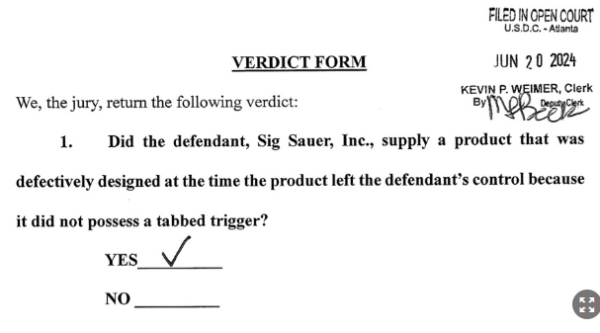You may have heard about a recent jury verdict (June 20, 2024) against SIG SAUER. If you haven’t, a federal court in Georgia awarded $2.3 million to Robert Lang, who asserted -depending on which statement you read- that his P320 either: 1) went off by itself, 2) was influenced by an unknown foreign object, or 3) discharged as Mr. Lang was removing it from his now-broken holster.
This case was especially intriguing, because thirteen other times attorneys have tried to convince either a judge or juries that there was an inherent design flaw in early SIG P320 triggers that could cause them to discharge. All thirteen of those cases failed.
So what was different about this one? The answer is as clear as a foggy London morning. But it’s no reach to say this case was decidedly “different” from prior ones.
Apparently, Mr. Lang’s case didn’t require a lengthy evaluation of a myriad of facts by the jury. Normally, a trial asserting some sort of product safety issue would introduce hundreds, if not thousands, of pages of contradictory evidence, from “expert statements” to design drawings.
The Lang case, in contrast, appeared to have been boiled down to its very essence. In product liability trials, that’s very different. And it’s reflected in the Verdict Form submitted by the jury.
Here’s the Verdict Form as filed in Atlanta federal court.

Reading this as written, it seems the jury was convinced that there was nothing wrong with what SIG built, but the fact it lacked a “tabbed trigger” somehow constituted a defective design.
Last time I checked, the features on a firearm dictated what you purchased. SIG doesn’t put a “tabbed” trigger into the P320 and that constitutes “negligence”?
My gun choices have always been driven by features I wanted.
Had Mr. Lang wanted a tabbed trigger, he could have purchased a GLOCK or any other of the firearms sold with a tabbed trigger.
SIG doesn’t put “tabbed triggers” into their pistols.
And the tabbed trigger does nothing to prevent negligent discharges; they’re designed to lessen the chances of an (inertia) accidental discharge if/when dropped. That wouldn’t do anything for Mr. Lang’s situation, whether the trigger was pulled via a failed holster, a mysterious foreign object, or even an accidental finger slip when drawing.
SIG will appeal. They appear confident their appeal case is strong. But that’s up to the courts to decide.
Here’s SIG’s full statement:
SIG SAUER strongly disagrees with the verdict in the case of Lang v. Sig Sauer, Inc. and will be appealing the decision on multiple grounds.
SIG SAUER does not believe that Plaintiff has met his burden to prove the P320 model pistol was designed defectively or negligently as claimed. There are no facts on the record to support that Mr. Lang’s discharge claim was the result of anything other than his own negligent handling causing him to pull the trigger on the P320 pistol. Plaintiff and both his experts testified that they do not know what pulled the trigger or how the trigger was pulled, and they did not attempt to conduct any testing to confirm how the trigger could have been pulled, other than by Mr. Lang’s own finger.
In this case, the plaintiff, Mr. Lang, initially admitted to the police that he accidentally discharged his gun while pulling it out of the holster, then later changed his story, stating that the firearm discharged without a trigger pull. However, the Plaintiff’s story notably changed again, after hiring trial experts who agreed that the SIG SAUER P320 could not discharge without the trigger being pulled.
The design of the SIG SAUER P320 model pistol is truly innovative and safe, with numerous related patents, including several relating to safety mechanisms. It is one of the most tested, and proven handguns in recent history, with versions being selected as the official sidearm of the U.S., Canadian, Australian, and Danish militaries, among many other military and law enforcement organizations worldwide. SIG SAUER is extremely proud of our long history of producing high-quality firearms and our unwavering dedication to safety.
From here, it looks like it will be quite a while before any checks not made out to law firms will be cashed in this case.
As always, we’ll keep you posted.
—Jim Shepherd